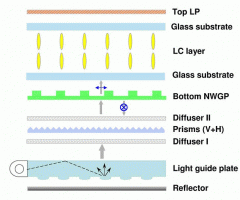October 3, 2008 feature
Nanowire technology could make LCDs brighter, thinner, and cheaper

(PhysOrg.com) -- As nanoimprinting technology advances, scientists have shown that using nano-sized polarizers could significantly enhance the contrast ratio in liquid crystal displays (LCDs). For consumers, that means that TVs, computer monitors, and especially mobile displays could become brighter, lighter, and thinner in the future.
Scientists Zhibing Ge and Shin-Tson Wu from the University of Central Florida in Orlando have presented their improved LCD design in a recent issue of Applied Physics Letters. They used a nanowire grid polarizer (NWGP) for backlight recycling, which enhances the LCD’s optical efficiency and thereby reduces its power consumption.
“The method for fabricating large area wire-grid polarizers is advancing rapidly, benefiting from the huge research momentum of nano-imprinting technology,” Wu told PhysOrg.com. “Nowadays, it is possible to fabricate NWGPs with a pitch of 100 nanometers or smaller. Different from the reflective polarizers made from multilayer films, WGP is a grating structure which can exhibit a very high transmission contrast ratio. As a result, it holds potential for replacing the bottom sheet LP which is close to the backlight side in a LCD.”
In conventional LCDs, the devices are sandwiched between a top and bottom layer of linear polarizers. While linear polarizers can provide a high contrast ratio (the difference between bright and dark luminance), they also tend to absorb more than 60% of the device’s backlight, resulting in a maximum light transmittance of just 40%.
Ge and Wu show how replacing the bottom linear polarizer with a light-recycling NWGP, and keeping the top linear polarizer as it is, can improve the device’s optical efficiency. The scientists explain how the recycling process works: when unpolarized light from a source (such as a cold cathode fluorescent lamp or light-emitting diode) reaches the NWGP layer, only waves traveling perpendicular to the wire grids (p-waves) can penetrate the NWGP, and are transmitted. Waves traveling parallel to the wire grids (s-waves) are first reflected back to a light guide plate for recycling, but then they bounce back to the NWGP again.
By reflecting back and forth, the s-wave has more chances to be converted to a p-wave and transmitted through the NWGP. This recycling process repeats several times before the light is absorbed or scattered away. As a result, the overall light efficiency can be improved by about 60%, as compared to using two linear sheet polarizers.
Besides the increased efficiency, NWGPs could offer some other advantages compared with conventional LCDs. The NWGP that the scientists used here was only 200 nanometers thick (the linear polarizer is 210 micrometers thick), which would not only decrease unwanted light absorption, but also minimize light leakage and enable ultra-thin displays. In addition, the linear polarizer-NWGP configuration can provide a wide viewing angle: the scientists achieved a 100:1 contrast ratio across a 75° viewing cone using a conventional multi-domain vertical alignment LCD.
“We plan to work with our contract sponsor Chi-Mei Optoelectronics Corporation to make test devices for this new device configuration,” said Ge. “In addition, we will apply this nano-wire grid polarizer technology to sunlight readable transflective LCDs for mobile devices and 3D displays. If the performance is good and cost is acceptable, then we expect this technology will have widespread applications in the consumer market in the near future.”
More information: Ge, Zhibing and Wu, Shin-Tson. “Nanowire grid polarizer for energy efficient and wide-view liquid crystal displays.” Applied Physics Letters 93, 121104 (2008).
Copyright 2008 PhysOrg.com.
All rights reserved. This material may not be published, broadcast, rewritten or redistributed in whole or part without the express written permission of PhysOrg.com.




















